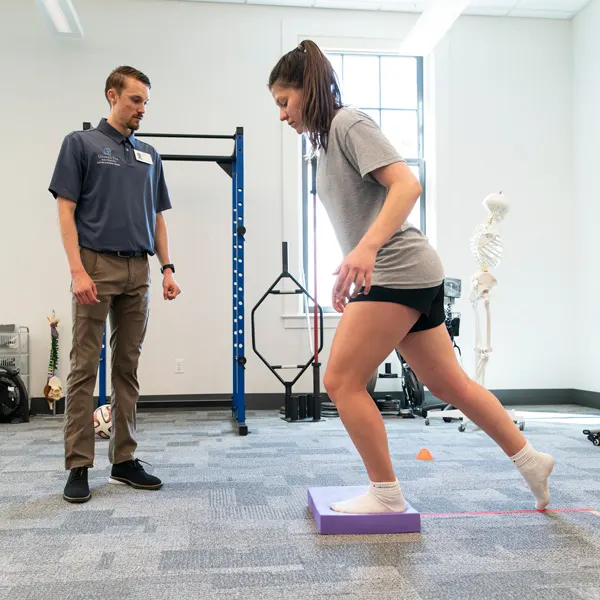
Occupational Therapy vs. Physical Therapy Explained
by Stanley Paul, OTR/L, PhD, MD; and Jeff Houck, PT, PhD
Occupational therapy (OT) and physical therapy (PT) are distinct but closely related professions that often collaborate as part of a patient’s rehab team. Because of overlapping settings and shared goals, they’re sometimes mistaken for one another — but each brings a unique focus to patient care.
Both occupational therapists and physical therapists work with people of all ages to help them regain function after an injury or illness, with the goal of improving their overall health.
The main difference between these occupations is where the focus lies:
- The primary goal of an occupational therapist is to improve a patient’s ability to do meaningful daily activities through adaptations, skill-building, and cognitive or physical support.
- The primary goal of a physical therapist is to improve a patient’s ability to move their body.
Physical therapist and George Fox University physical therapy professor Christen Johnson says the relationship between the two professions is very collaborative:
"On a single team, PTs and OTs often spend more time with each other than with therapists from their own discipline because they share a patient or client. PTs and OTs regularly get to combine their skill sets and benefit from the other's perspective. This close partnership between two different healthcare professionals on behalf of one patient is unique and powerful when they can leverage each other's skills to the patient's advantage."
Stanley Paul, director of George Fox's occupational therapy doctorate program agrees:
"PT and OT are sister professions where the principles of patient-centered care, holistic approach to rehabilitation, and teamwork are shared by both professions and underscore their ability to work together effectively for improved patient outcomes"
Terms Defined
Occupational therapy is the evaluation and treatment of people who have injuries, illnesses or disabilities to help them develop or regain skills needed for the activities of daily living, such as bathing and showering, grooming, dressing, getting out of bed and feeding themselves.
Physical therapy is the hands-on evaluation and treatment of movement dysfunction through exercise prescriptions and patient education with an eye toward strengthening, restoration and optimal performance.
The Similarities
The similarities between the two professions stem from the basic and clinical training required for each. Both rely heavily on health sciences associated with movement, which include biomechanics, kinesiology and motor control. A basic understanding of common diseases that influence movement require knowledge of anatomy, neuroscience and physiology.
Both physical and occupational therapy rely on these basic sciences to help patients recover from injury or surgery, manage chronic conditions, and maintain a healthy lifestyle through prevention and wellness programs.
As a result, these similarities in training often mean physical therapists and occupational therapists do the same work. For example, 85% of certified hand therapists are occupational therapists and 15% are physical therapists.
In addition, both forms of therapy work with people of all ages who have any single or combined health condition that affects their ability to complete daily functions, move, and engage socially.
This may include individuals who have experienced or been diagnosed with:
- A spinal cord injury
- A stroke
- Cancer
- A progressive neurologic disease
- A cardiopulmonary disease
- Development delays in children
The path to becoming either an OT or PT requires completion of an accredited graduate program and passing a licensing exam. Physical therapists receive a doctorate in physical therapy after two to three years of post-bachelor’s training, while occupational therapists complete either a master’s degree (MOT) or a doctorate in occupational therapy (OTD) prior to a licensing exam.
The Differences
Differences start to emerge with the goals and focus of these related disciplines:

The Role of Occupational Therapists
Occupational therapy focuses on retraining to perform functional tasks and integration into new or previous social roles (e.g. work). Therefore, clinical training for occupational therapists focuses more on psychosocial issues, activities of daily living, and reintegration with work roles.
Occupational therapists typically work on and provide recommendations for:
- Activities of daily living (ADL), such as bathing, dressing and eating
- Adaptive equipment, such as shower chairs, or equipment to make daily tasks easier
- Caregiver and family training
- Planning and making the most of daily routines
- Returning to work, school and leisure activities
- Techniques to aid in memory, concentration and executive functioning (e.g., planning and prioritizing, functional cognition)
- Falls prevention, home safety assessments, and accessibility
Occupational therapists can help patients ranging from a child with autism, an older adult following a stroke and a young person who had a traumatic brain injury to an athlete who had a shoulder injury, a wounded warrior with a double amputation, and an older adult with arthritis who wants to live independently.

The Role of Physical Therapists
Physical therapy traditionally focuses on the diagnosis of movement dysfunction and physical restoration of the body to enhance quality of life. This has led to a significant role in management of common musculoskeletal injuries.
Recently, how mental health influences recovery and disease management has also become a focus. Physical therapy typically offers multimodal care to personalize the experience for patients. The focus is to meet each person’s individual goals through restorative approaches and return to preferred physical activities.
Physical therapists typically do the following:
- Review patients’ medical history and referrals or notes from doctors, surgeons, or other healthcare workers
- Diagnose patients’ functions and movements by observing them stand or walk and by listening to their concerns
- Develop individualized plans of care for patients, outlining the patients’ goals and the expected outcomes of the plans
- Use exercises, stretching maneuvers, hands-on therapy and equipment to ease patients’ pain, help them increase their mobility, prevent further pain or injury, and facilitate health and wellness
- Evaluate and record their patients’ progress, modifying the plan of care and trying new treatments as needed
- Educate patients and their families about what to expect from the recovery process and how to cope with challenges throughout the process
Physical therapists can work with anyone of any age, including those experiencing pain, recovering from surgery, athletes, postpartum individuals, children with developmental delays, older adults at risk of falling, and those with other complex medical conditions.
How OT and PT Might Approach the Same Patient
One of the clearest ways to understand the differences between occupational therapy and physical therapy is to look at how each profession supports the same patient in different ways. As part of a rehab team, OTs and PTs often work together, focusing on different aspects of recovery that, together, help patients reach their goals.
The examples below show how an OT and a PT might approach care for the same individual, each contributing a unique perspective and skill set to improve the patient's overall quality of life.
-
Parkinson's Disease
An 80-year-old patient with Parkinson’s disease is experiencing frequent falls and difficulty eating due to hand tremors.
The physical therapist focuses on improving the patient’s balance, strength, and ability to walk safely — for example, practicing how to open a door or leave the house without falling.
The occupational therapist works on adaptive strategies and tools to help the patient eat more independently, such as weighted utensils or tremor-reducing devices, and may address the emotional impact of eating difficulties on the patient’s social life.
-
Stroke Recovery
An older adult with mild cognitive decline recently returned home from the hospital after a fall caused by taking the wrong medication at the wrong time.
The physical therapist helps the patient build strength and stability to reduce fall risk and increase independence with walking and daily movement.
The occupational therapist addresses medication management — helping the patient use a pill organizer, set up phone reminders, or integrate assistive devices to safely follow a daily routine.
-
Stroke Recovery
A patient recovering from a stroke has weakness on one side of the body, affecting both walking and the use of an arm and hand.
The physical therapist works on improving gait, balance, and lower body strength to help the patient move safely and confidently.
The occupational therapist focuses on restoring function in the affected arm and hand — helping the patient relearn tasks like brushing teeth, dressing, or preparing meals.
-
Early Intervention Program
A young child diagnosed with autism at 15-months who has a developmental delay.
The physical therapist focuses on development of coordinated movements and skill acquisition through big motor play.
The occupational therapist focuses on progressive, graded exposure and desensitization to sensory stimuli and how their ability to process different stimuli connects to their ability to socialize, play, and learn.
Where do OTs and PTs Typically Work?
Physical and occupational therapists work in similar settings:
Work Settings for Occupational Therapists
The Bureau of Labor Statistics reported that the largest employers of occupational therapists in 2023 were:
- Hospitals: 29%
- Offices of physical, occupational and speech therapists, and audiologists: 28%
- Elementary and secondary schools: 13%
- Home healthcare services: 8%
- Skilled nursing facilities: 7%
OT services are provided by licensed occupational therapy clinicians (occupational therapists and occupational therapy assistants) in a wide range of locations, including:
- A patient’s home
- Community settings (e.g., outpatient clinics, community centers, shelters)
- Hospitals
- Assisted living facilities
- Senior homes
- Nursing homes
- Outpatient clinics
- Primary care offices
- Schools
OT clinicians may work as consultants or as assistive technology and health information providers, and in the areas of human-centered design, addressing the health of communities, education (e.g. schools, higher education), health promotion programs, driving and community mobility, and low-vision therapy.
Work Settings for Physical Therapists
According to the Bureau of Labor Statistics, the largest employers of physical therapists in 2023 were:
- Offices of physical, occupational and speech therapists, and audiologists: 35%
- Hospitals: 28%
- Home healthcare services: 10%
- Nursing and residential care facilities: 6%
- Self-employed: 4%
They may work in the following arenas/areas of treatment:
- Sports medicine
- Orthopedic injuries
- Cardiopulmonary rehabilitation
- Neurologic diseases
- Cancer management
- A host of chronic conditions
Recently, physical therapy has focused on behavior change as an outcome to prevent and help manage chronic conditions.
High Job Satisfaction
Both personal stories and national rankings suggest high job satisfaction in physical and occupational therapy.
U.S. News & World Report ranked occupational therapy as the #4 best healthcare job and #19 best overall job in the U.S. in 2024. Similarly, the same rankings placed physical therapy as the #7 best healthcare job and #30 best job overall.
Job Outlook
According to U.S. Bureau of Labor Statistics (2023), employment of physical therapists is projected to grow 14% from 2023 to 2033, much faster than the average for all occupations. Likewise, employment of occupational therapists is projected to grow 11% over the same time period. Over 13,000 openings for physical therapists and 9,000 openings for occupational therapists are projected for each year.
The median salary for each profession is very similar, with physical therapists earning a slightly higher median annual income (see table below). However, for a doctoral-trained OT salary estimates are between $80,000 and $95,000 (ZipRecruiter, 2023). In addition, salaries vary between different states, with the state of Washington paying the highest and North Carolina paying at the lower end of the spectrum for occupational therapists.
| Physical Therapy | Occupational Therapy | |
|---|---|---|
| Median Pay (2023) | $99,710 per year $47.94 per hour |
$96,370 per year $46.33 per hour |
| Number of Jobs (2023) | 259,200 | 150,500 |
| Projected Job Growth (2023-33) | 14% (Much faster than average) | 11% (Much faster than average) |
| Projected Jobs Added (2023-33) | 36,800 | 16,800 |
Bureau of Labor Statistics
Learn More
Still have questions? George Fox University’s Occupational Therapy Doctorate and Doctor of Physical Therapy sites offer more insight into the roles of the professions, the courses of study required to earn the respective degrees, and the financial aid available.